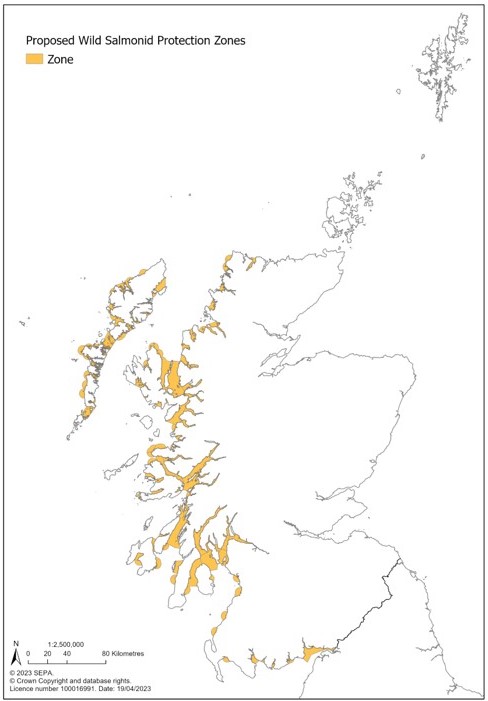SEPA unveils ‘risk map’ for sea lice control measures

The Scottish Environment Protection Agency (SEPA) has published more information on the zones where it believes sea lice pose the highest risk to migrating wild Atlantic salmon.
SEPA is consulting on the latest stage of its sea lice control measures, setting out a network of wild salmon protection zones in migration bottlenecks in coastal waters on the West Coast and Western Isles, such as sea lochs and sounds.
The Agency says the proposed zones would not be no-go areas for fish farms, but farmers operating within them all proposals for new finfish farms or increases in fish numbers at existing farms that could affect protection zones will be subject to risk assessment and appropriate permit conditions.
Farms in the areas identified could also be subject to tighter controls regarding sea lice monitoring, with stricter thresholds than in other areas.
Peter Pollard, Head of Ecology at SEPA, said: “The science is clear that Scotland’s wild Atlantic salmon populations have seriously declined over the last few decades and are now at crisis point. Safeguarding the future of Scotland’s ‘king of fish’ requires co-ordinated action and a broad range of interests working together to manage all the pressures they face in rivers and coastal waters, from climate change to migration barriers and sea lice.
“As Scotland’s environmental watchdog, SEPA’s new responsibilities on managing the risk to wild salmon and sea trout from sea lice offer an opportunity for a fresh, proportionate and evidence-based approach to working together on the shared challenge.
“Our modelling of wild salmon protection zones, built on international best practice, uses cutting edge science to triage risk and specifically builds in opportunities for additional modelling, monitoring, engagement and adaption. It does not lock in or out development in any area. What it might mean is farms in higher risk areas implementing tighter but achievable levels of sea lice control, with the sector having a good track record in innovating and adapting.”
SEPA said the second consultation, which follows an initial 2021 consultation and engagement with a range of stakeholders, outlines a proportionate, evidence-based regulatory approach to protect young salmon as they leave rivers and begin their journey to feeding grounds in the north Atlantic.

Wild salmonid protection zones (SEPA, April 2023)
The Scottish Government’s Wild Salmon Strategy, published earlier this year, aims to build resilience and transform the fortunes of wild Atlantic salmon through coordinated action to manage pressures in rivers and coastal waters, including the effects of climate change, barriers in rivers to migration, diffuse pollution, fish diseases and sea lice from fish farms.
Peter Pollard added: “We’ve worked hard to date to listen to a broad and often diverse range of views on the future regulatory landscape to support wild salmon. We understand views can be polarised and we’ll continue to listen during this further consultation, which we’re extending to ensure we hear directly from all those who share an interest in the framework and the future of wild Atlantic salmon.”
A series of workshops will be hosted with stakeholders during June, July and August 2023.
Detailed proposals for a risk-based, spatial framework for managing interaction between sea lice from marine finfish farm developments and wild salmonids in Scotland is available to view online. The consultation closes on 15 September.

